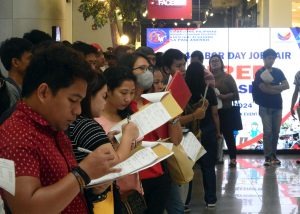The local banana export industry has called on government to establish exit price caps on the crop as among the interventions for the industry for it continue to exist as it has been facing key challenges, including the present situation in China as well as the emerging competition from other Asian countries.
In a press conference Friday, Alberto F. Bacani, chair of the Pilipino Banana Growers and Exporters Association (PBGEA), said the exit price cap, or the price imposed on the crop before it is shipped to its destination, will allow the companies to become flexible in terms of drafting their programs for sustainability.
In Ecuador, one of the biggest exporters of the crop, “the government heavily intervenes in terms of pricing,” BAcani said, pointing out that the Ecuadorean government implements both a minimum and a maximum pricing caps to ensure the growers earns and the commodity remains competitive when it reaches the market.
“What I would ask the government to do is to follow the model of Ecuador,” he said, adding that open pricing is better only when the market price is high, but that exporters face huge problems when the market price goes down.
He said the government should study the proposal as the local industry must be competitive so that “we should not (become) an expensive banana.”
At present, exporting companies signed up agribusiness venture agreements with the growers they buy from, particularly agrarian reform beneficiaries, to ensure that the produce are bought and that these same companies provide financial and technical assistance to the growers.
By doing so, Bacani explained, exporting companies do not have that flexibility especially if the prices in the markets go down.
Victor S. Mercado, association president, said the problem is when there is a glut in the markets as well as the influx of other fruits into these markets that result in lowering of prices of bananas.
Growers that have contracts with their buyers are in a better position, but those that do not have “they have big problems” because buyers will not buy from them or they will be forced to sell their produce at very lower prices just so they could recoup their production costs, Mercado added.
In the last quarter of last year, he said, many growers faced the problem as prices in the international markets are “seasonal.”
The news about the Novel Coronavirus has also raised concerns among the shipping companies that it is very hard to ship cargoes to China, considered the biggest market at present as it buys about a third of the total exportable volume and has overtaken Japan as the main market for Philippine bananas, Bacani said.
“What is scary is we have become dependent on the China market,” said Bacani, pointing out that whatever the issues that the China market has to face, these will impact on the local industry.
Some Chinese buyers have also been communicating with local growers and that there are indications that they would not buy as a result of the virus scare, said Mercado.
Bacani added that the country has also lost a huge market in Iran as a result of the sanctions that the American government has imposed on the country and that it has not found any other alternative markets for the product aside from the traditional markets like Japan and South Korea.
As of November 2019, based on the data from the Philippine Statistics Authority (PSA), the value of exported Cavendish banana went up to $1.8 billion from $1.38 billion during the entire 2018.
Mercado said that although the value was higher, based on the data of the association, production went down to 207 million metric tons in 2018 to about 195 million metric tons last year.
This was because, for one, last year there was a mild drought that its effect is expected to continue this year, he said.
“But the biggest that the threat that has really caused the reduction (in the size of the farms) is Panama disease,” he said as he noted that the infestation has led some companies have abandoned their farms.
PSA data also showed that 88,667 hectares are planted to the crop, or about 20% of the total area planted to banana varieties, although the association said that the area planted to the crop has shrunk as more farms, especially smaller ones, have failed to control the spread of Panama disease, or Fusarium Wilt, a soil-borne infestation that renders a farm useless.
The Department of Agriculture has started conducting a survey of the total area of farms affected by the disease as the association estimated it at about 30,000 hectares.
In other countries like those in Latin America, said Mercado, the government has intervened to ensure that the infestation is contained.
He added that it is also very hard to replace infected areas with new farms. “The big problem is that it is hard to look for areas to plant,” he said, pointing out that aside from the needed infrastructure facilities like ports, most areas have been placed under agrarian reform, although some companies have leased back the farms that they have distributed to the farmer-beneficiaries and making them earn both as rental collectors and as workers.
He said there is a need for government to also enhance quarantine processes to ensure that the infestation is slowly curbed, if not completely eliminated, as there is fear that the infestation would become wider.
The industry has also started adopting a Panama disease-resistant variety, but its propagation has not been much because of the needed interventions like irrigation systems.
Bacani said that the variety can be used in rehabilitating the farms affected by the infestation just like what his company has done in Bukidnon where its 280 hectare farms shrank to about 130 hectares. At present, the company has started planting the variety in the affected area and there is a big possibility that its production will return.
“It is where government assistance is needed,” he said, adding that what the government can do is to help the growers both in terms of technical and financial assistance so that they will slowly adopt the variety.
Another huge challenge, said Mercado, also the president of the Marsman-Drysdale Agribusiness Group, is that some Asian countries that have started planting banana have been poaching the technical experts of the local industry.
These countries, he said, have started developing their Cavendish banana industry with the help of the Chinese companies because they are nearer to China and the Philippines.
Because of the expertise of the Filipino technicians hired to help the industry in the Asian countries, Mercado said companies have been able to plant huge farms. “They can plant from 50 hectares to 500 hectares a day,” he said.
“Their biggest (advantage) is that they are closer to China,” he said as a container of banana from Vietnam to China is about $500 compared with $150 is shipping the same volume of cargo from the Philippines to the same destination.
Bacani said his company, Unifrutti Tropical Philippines Inc. where he sits as president, even sent a team to Cambodia to look into the progress of the banana industry.
“It’s scary,” said Bacani, although he added that the Philippine banana industry is still superior mainly because, for one, the labor force there “is still hard to manage.
“It will take a while before they (other countries in Asia) can catch up with the Filipino way of growing bananas,” he said, although he warned that the government should start helping the industry because it might eventually lose to competition.



